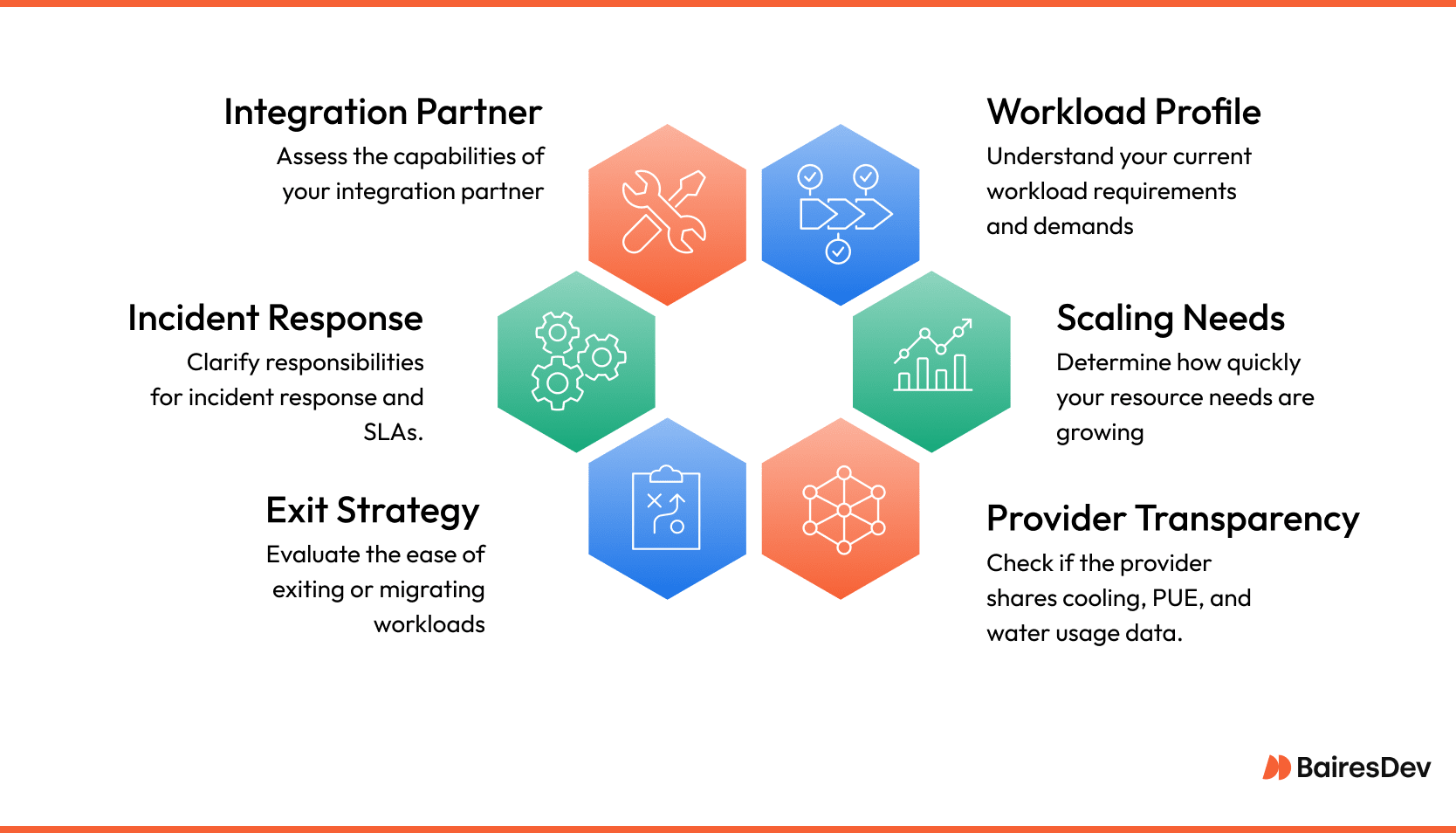Your workloads are scaling like Slack, but your resources aren’t. Every day, your engineering team pushes for more capacity. Meanwhile, cloud service costs are mounting, with unexpected surcharges adding pressure.
For most companies, hosting decisions are enough to turn your hair a different color. One bad call and you’re locked into a hyperscale facility that’s optimized for someone else’s needs, not yours.
Today’s enterprise data centers have to be flexible. Choose a model that can’t adapt, and your infrastructure investment could become a sunk cost liability. Choose the the right one, and your infrastructure adapts as you grow, under budget—especially when underpinned by robust devops solutions that automate scaling and governance.
When Urs Hölzle built Google’s first hyperscale facility, he couldn’t have predicted AI bubbles or multi-cloud issues. But he planned for scale. So should you.

According to Precedence Research, the hyperscale market exhibits a robust growth trajectory, projected to expand from $167.0 billion in 2025 to $571.6 billion by 2030, which represents a compound annual growth rate (CAGR) of 27.90%.
What Is a Hyperscale Data Center?
A hyperscale data center is a massive facility built for extreme scale, high-density servers, and nonstop automation. Unlike traditional data facilities, they support enterprise data, cloud computing services, and AI workloads with optimized data processing, uptime, and energy efficiency.
A hyperscale platform operates as the digital backbone for cloud service providers, powering everything from streaming platforms to artificial intelligence models like ChatGPT. Hyperscale sites are different from garden variety data centers. They’re optimized for energy efficiency and scale.
Hyperscale operators like AWS and Google aren’t expanding because they like building glass fortresses in cornfields. They’re chasing global cloud service demand and latency-sensitive workloads. While the average data center keeps up with business IT needs, hyperscale centers fuel entire digital economies.
A Brief History of Hyperscale Development

Urs Hölzle, Google’s infrastructure pioneer, helped shape what a hyperscale build looks like. He used machine learning to optimize cooling systems, and drove down power usage effectiveness (PUE). His work set the bar for what companies now expect from hyperscale architecture.
Take Finland, where Google built a hyperscale facility in Hamina, using seawater for cooling systems and partnering with locals for community alignment. That model cut power draw drastically and improved user trust in the process.
Still, hyperscale isn’t heaven. You gain capacity, but give up flexibility. You reduce costly outages with redundant design, but risk deep lock-in with a single vendor. That’s why many companies now blend hyperscale compute with colocation or edge services. This lets them hedge against price shocks and shifting needs.
Choose hyperscale, and you’re buying into a machine built for scale. But it won’t run on your terms unless you control the orchestration layer.
Hyperscale vs. Colocation vs. Hybrid
The International Energy Agency predicts that energy consumption for enterprise data centers will rise 120% from 2022 through 2026. That’s largely due to inefficient workload placement. Getting your model wrong can strain your budget while it slows your team.

Hyperscale is built for relentless data processing, not every workload needs that. If your compute is spiky, your storage bursty, and your governance tight, hybrid lets you match the right job to the right stack. Use hyperscale for elastic data storage and AI inference. Keep backups or compliance-critical systems in a colocation setup for control.
Whether you’re China Telecom or a U.S. SaaS startup, the choice to use a hyperscale center vs an alternative impacts more than latency. Land, permitting, energy sources, and climate matter. Urban builds have speed, but a middle-of-nowhere build may offer cheaper renewable power, ASHRAE-friendly zoning, and fewer environmental protests.
Smart Hosting Decisions Start With the Right Questions
You’ve just wrapped your QBR and the board’s on fire for AI. Your machine learning workloads are scaling fast, customers are demanding SLAs, and your ops lead is asking if the colo can handle liquid loops. But you? You’re calm, because you’ve already pressure-tested every key factor in your hosting plan.

Here’s the checklist smart companies use to avoid vendor lock-in and runaway complexity with hyperscale data centers:
- What’s your workload profile?: Are you running AI inference, serving static content, or doing high performance computing? Different needs demand different hosting mixes across data facilities.
- How fast are your needs scaling?: If you’re consuming massive amounts of compute, you need infrastructure that supports a scale-out mindset and tooling that automates the orchestration.
- Is your provider transparent with cooling/PUE/water metrics?: Don’t accept vague answers. Ask about liquid cooling, air systems, and PUE benchmarks. The wrong cooling stack kills budgets.
- Can you exit or migrate if workloads shift?: Flexibility isn’t optional. AI today might be machine learning tomorrow. Plan for workload evolution and never get caught in a one-way door.
- Who owns incident response and SLAs?: Know exactly who answers when something breaks, especially in hybrid or large hyperscale environments.
- Is your integration partner up to the task?: Orchestration, automation, monitoring. If your partner can’t stitch it together, your infrastructure won’t fit large scale deployments.
Smart buyers don’t just choose based on hyperscale data marketing slides. They demand clarity and build infrastructure that performs under pressure. That’s as true in the cloud as it is in the largest data center on their roadmap.
Plan for Cost Resilience
Hyperscales are efficient, but they aren’t always cost-effective. The right architecture balances performance with financial durability, even when conditions change.
Hyperscale providers may bill based on usage. That means costs can balloon with AI workloads or regional replication. Hybrid models offer more predictable cost structures by isolating steady workloads in colocation environments while flexing data center usage for elastic needs.
CapEx vs. OpEx also matters more than it seems. Buying dedicated space in a colocation facility can improve your depreciation schedule, while renting compute from a hyperscale data center increases OpEx and budget volatility. The right mix depends on how your finance team models ROI and how flexible your roadmap needs to be.
Hidden Costs
Watch for hidden cost triggers like bandwidth overages, cooling surcharges, ramp-up windows, or contract minimums based on aggressive projections. Smart infrastructure leaders don’t just compare price-per-core.
They model total cost of ownership across scenarios and demand vendor transparency. A hyperscale deployment can deliver huge efficiency gains or leave you overcommitted. It all depends on how you buy, monitor, and evolve your hosting strategy.
Plan for the AI Curve
Executive teams see opportunity. Product teams want low-latency inference. But the workloads behind can spike, fade, or change suddenly from GPU to CPU. Building infrastructure that assumes consistent, high-intensity AI use is a fast way to overcommit capital and burn flexibility.
The companies that overbuilt for crypto or early cloud know the pain: stranded assets, ballooning OPEX, and half-empty facilities that no one wants to retrofit. That’s the risk, but there’s a fix.
Choose Resilient Infrastructure
If your AI footprint is tied to one platform or provider, you’re exposed. Even Google Cloud Platform has pulled back on large-scale rollouts. The smartest infrastructure leaders reduce that risk by diversifying hosting models, choosing vendor-flexible contracts, and planning for workload shifts.
Consider the amount of compute you’ll need along with how easily you can rebalance. If AI demand softens, can you shift workloads to colocation for control? Can you dial back hyperscale usage without rewriting your entire orchestration stack? Build an infrastructure plan that stays stable when demand surges or stalls.
How BairesDev Helps You Stay Scalable
Staying sane in a hyperscaler strategy depends on confidence in your infrastructure. That means your automation doesn’t break under pressure and your team won’t collapse trying to maintain sprawling systems. BairesDev provides the engineering support and infrastructure expertise that internal teams often lack at scale.
- Cloud orchestration: BairesDev simplifies complex orchestration across large scale deployments using Kubernetes, Terraform, and containerized workloads, helping companies run apps that span colocation and hyperscale environments—without sprawl or chaos.
- CI/CD and DevOps: Our teams deliver infrastructure-as-code and automation pipelines that actually work. They streamline code delivery, integrate with your monitoring stack, and reduce the risk of bottlenecks inside data centers.
- AI pipeline optimization: BairesDev maps workloads to available compute and storage, aligning high performance computing with real needs—so you’re not overbuilding or wasting expensive GPUs in the wrong environment.
- Security & observability: With Zero Trust, proactive monitoring, and built-in threat response, BairesDev supports sensitive environments, even inside complex citadel campus zones—where security isn’t a bolt-on.
- Hybrid-ready integrations: We connect and manages workloads across hyperscale and colocation environments. Whether you’re scaling AI or improving cooling efficiency, their team automates smart decisions on power draw, fiber pathing, and scale.
BairesDev helps you design for what hyperscale demands and what real operations require. No hyperscaler squeeze headaches. Just results, redundant to the core, stability-first, and ready to adapt when everything else is changing.
Frequently Asked Questions
If you’re weighing colocation, hybrid, or a full hyperscale move, you probably have a few of the questions below. Here are real answers to key questions decision-makers ask.
What’s the difference between a hyperscale data center and traditional data centers?
A hyperscale center is built for massive scale, automation, and efficiency. Traditional data centers support steady-state workloads, while hyperscale facilities power elastic demand like AI, SaaS, and global platforms.
When should we consider moving beyond colocation to a hyperscale model?
If you’re hitting performance ceilings or managing high-volume, bursty workloads, it’s time to explore the largest hyperscalers. They offer better scaling, improved interconnects, and more advanced air distribution systems.
Can hyperscale infrastructure help meet sustainability goals?
Yes. Many hyperscale facilities are sited near renewable energy sources. These data centers often outperform smaller sites in energy use, thanks to modular cooling and efficiency standards not always seen in legacy builds.
How do we avoid lock-in when working with a hyperscalers?
Choose a vendor that supports open APIs, neutral tooling, and flexible contracts. Lock-in risks rise when orchestration is tightly tied to a single provider. Hybrid setups using multiple hyperscale data centers can also reduce long-term exposure.
What efficiency metrics should we track in a hyperscale deployment?
Power Usage Effectiveness (PUE), thermal compliance, and water usage are key. Ask hyperscale data center operators for transparency around renewable energy sourcing and air distribution systems. The best hyperscalers treat these as baseline—not premium—metrics.
Are hybrid models easier to manage than a single hyperscaler?
For many enterprises, yes. A hybrid approach combines the elasticity of a hyperscale approach with the control of colocation. It can simplify governance, reduce cost spikes, and give you room to pivot without rebuilding your strategy.
How do hyperscalers compare to traditional data centers on scalability?
Hyperscale data centers are designed for rapid scale-out and automation. Traditional centers can’t match the provisioning speed or workload elasticity of hyperscale facilities, especially when supporting AI or distributed services across the largest hyperscalers.






